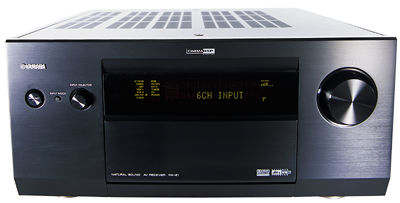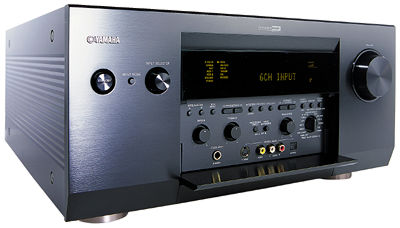Yamaha RX-Z1 A/V receiver

Of course, the state of the art has improved somewhat since the days of my first receiver. Dolby Digital and DTS multichannel formats abound, and the number of components in a typical system has increased dramatically. In addition, DVD-Audio and SACD require a 6-channel analog input. As a result, receivers have become much larger, with multitudes of connectors on their back panels and far more complex user interfaces. I wondered if Yamaha had kept up with the times.
Outside In
Like most modern A/V receivers, the Rx-Z1 is large and heavy, but its front panel is elegantly clean in appearance. Except for the main volume knob, input-selector knob, input-mode button, and power switch, all front-panel controls are found behind an oil-damped fold-down door that feels very solid and secure. Also behind the door is one set of A/V inputs with S-video, composite video, stereo audio, and an optical digital input.
Among the hidden controls is a Rec Out/Zone 2 selector, which lets you send the signal from any input source to Zone 2 or to all recorder outputs simultaneously, independent of the main source. (The switching circuitry prevents a recording source, such as a VCR, from sending a signal to itself.) Yamaha has long provided a rec-out selector like this on their receivers, something I've always appreciated as I do a lot of recording while watching or listening to another source.
The front-panel display is attractive and well-organized. Most of the real estate is taken by an alphanumeric display that indicates the current DSP program and, when the user is adjusting parameters, other information: main input source, surround mode, main volume, active channels, etc. Everything is easy to distinguish at a glance.
Likewise, the rear panel is well-organized, although, as usual, the S-video connectors are too close together for large plugs like those on my AudioQuest S2 cables. The subwoofer outputs are unusually flexible, with options for mono or stereo subs. There's also a speaker impedance-selector switch. In one position, the receiver expects to see all speakers with at least 8ohms impedance; in the other position, it expects to see all speakers with at least 4ohms impedance (except the front effects speakers, which need at least 6ohms).
The analog audio, composite video, and S-video ins and outs are fixed, but the component-video inputs and digital audio ins and outs are assignable, and their names, as they appear in the onscreen display (OSD) and the front-panel alphanumeric display, can be changed. However, the smaller source indicator in the left portion of the front-panel display retains the default names, which could be confusing. The component-video signal path has a bandwidth to 100MHz, making it fully capable of handling 480p and all HDTV signals. As with most (but not all) A/V receivers and surround processors, the composite and S-video signals are not upconverted to component, and the OSD is not available from the component monitor output. This means you must connect the S-video and/or composite monitor outs to the display in addition to the component connection in order to see the OSD and view sources that have these outputs. It also means you have to switch inputs on the display, which is a pain. I wish all receiver manufacturers would take a cue from Denon and Pioneer, whose flagship receivers upconvert all video signals to component, then send them and the OSD to the display through a single component connection.
The Rx-Z1 is well suited to custom installation with a Zone 2 A/V output (composite and line-level stereo audio), RS-232 port, two hardwired remote inputs, one remote output, and a 12V trigger output. In addition, the receiver's software (including available surround modes and processing algorithms) can be upgraded via the RS-232 port.

The IR remote is a backlit LCD touchscreen type (320x240 pixels) that closely resembles the Philips Pronto. It comes preprogrammed with codes for 500 brands of equipment, and it can learn commands from other IR remotes. In addition, it can be programmed from a computer via RS-232. It has a large (2MB) memory, and macro commands can be up to 255 commands long. I don't usually like LCD touchscreen remotes because you can't find buttons by feel in a dark room; you must look at them. This remote was somewhat confusing at first, but I got the hang of it pretty quickly.
The OSD has three modes—Full, Short, and Off—which determine how much (if any) information is presented. Unfortunately, the OSD is overlaid on the current video signal, which makes it hard to read. There are no adjustments that affect the video image, so the OSD should appear on a solid-color background; the only way to achieve this in the Rx-Z1 is to select an unused input.
Inside Out
The Rx-Z1 is built within an anti-vibration, anti-resonance chassis. The anodized heatsinks are so efficient that no fan is normally required. The power block has a fan, but it switches on only in conditions of extreme heat; I didn't hear it go on once during the entire review period.
The audio-design philosophy behind the Rx-Z1 is called Digital Total Purity Audio Reproduction Technology (Digital ToP-ART), the goal of which is to maximize digital quality while minimizing analog circuitry. To this end, the receiver uses 10 Burr-Brown PCM1704 24-bit/192kHz DACs, two Yamaha YSS-910 44-bit DSP chips for soundfield processing and system configuration, and a Yamaha YSS-938 32-bit floating-point processor to decode all the various Dolby and DTS surround formats. A Processor Direct switch connects the processor board directly to the power-amp section, bypassing the front-panel Tone and Balance controls and thereby shortening the signal path to improve the sound quality. The Rx-Z1 does use analog volume control to maintain signal integrity at low levels, but it is digitally regulated.
The Rx-Z1 offers eight channels of amplification for six main channels plus two front effects speakers, which can also be used to drive stereo speakers in Zone 2 by manually connecting the Zone 2 line-level outputs to the front-effects amplifier inputs. According to Yamaha, low-impedance signal paths throughout the receiver improve channel separation. The high-power, discrete amplifier section is designed to provide a wide dynamic range, and the linear damping in the main L/R and center channels is said to maintain a high, stable damping factor for better frequency response and articulation.
- Log in or register to post comments




































































